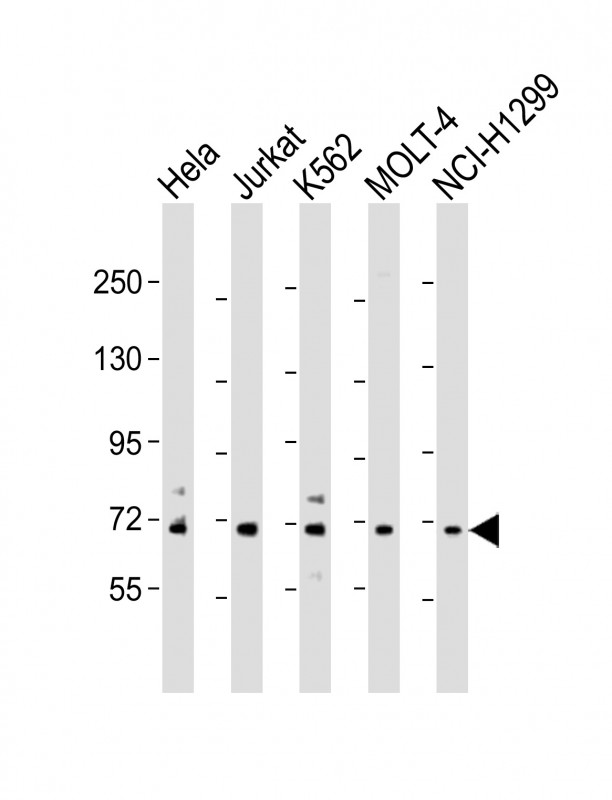NUP85 Antibody (N-Term)
Purified Rabbit Polyclonal Antibody (Pab)
- SPECIFICATION
- CITATIONS
- PROTOCOLS
- BACKGROUND

Application
| WB, E |
|---|---|
| Primary Accession | Q9BW27 |
| Reactivity | Human |
| Host | Rabbit |
| Clonality | polyclonal |
| Isotype | Rabbit IgG |
| Calculated MW | 75019 Da |
| Gene ID | 79902 |
|---|---|
| Other Names | Nuclear pore complex protein Nup85, 85 kDa nucleoporin, FROUNT, Nucleoporin Nup75, Nucleoporin Nup85, Pericentrin-1, NUP85, NUP75, PCNT1 |
| Target/Specificity | This NUP85 antibody is generated from a rabbit immunized with a KLH conjugated synthetic peptide between 163-195 amino acids from human NUP85. |
| Dilution | WB~~1:2000 E~~Use at an assay dependent concentration. |
| Format | Purified polyclonal antibody supplied in PBS with 0.09% (W/V) sodium azide. This antibody is purified through a protein A column, followed by peptide affinity purification. |
| Storage | Maintain refrigerated at 2-8°C for up to 2 weeks. For long term storage store at -20°C in small aliquots to prevent freeze-thaw cycles. |
| Precautions | NUP85 Antibody (N-Term) is for research use only and not for use in diagnostic or therapeutic procedures. |
| Name | NUP85 |
|---|---|
| Synonyms | NUP75, PCNT1 |
| Function | Essential component of the nuclear pore complex (NPC) that seems to be required for NPC assembly and maintenance (PubMed:12718872). As part of the NPC Nup107-160 subcomplex plays a role in RNA export and in tethering NUP96/Nup98 and NUP153 to the nucleus (PubMed:12718872). The Nup107-160 complex seems to be required for spindle assembly during mitosis (PubMed:16807356). NUP85 is required for membrane clustering of CCL2-activated CCR2 (PubMed:15995708). Seems to be involved in CCR2-mediated chemotaxis of monocytes and may link activated CCR2 to the phosphatidyl-inositol 3- kinase-Rac-lammellipodium protrusion cascade (PubMed:15995708). Involved in nephrogenesis (PubMed:30179222). |
| Cellular Location | Nucleus, nuclear pore complex. Chromosome, centromere, kinetochore. Cytoplasm, cytoskeleton, spindle. Cytoplasm. Nucleus membrane. Note=During mitosis, localizes to the kinetochores and spindle poles (PubMed:12718872, PubMed:16807356). Upon CCl2 stimulation translocates from the cytoplasm to the membrane and colocalizes with CCR2 at the front of migrating cells (PubMed:15995708). |

Thousands of laboratories across the world have published research that depended on the performance of antibodies from Abcepta to advance their research. Check out links to articles that cite our products in major peer-reviewed journals, organized by research category.
info@abcepta.com, and receive a free "I Love Antibodies" mug.
Provided below are standard protocols that you may find useful for product applications.
Background
Essential component of the nuclear pore complex (NPC) that seems to be required for NPC assembly and maintenance. As part of the NPC Nup107-160 subcomplex plays a role in RNA export and in tethering NUP98/Nup98 and NUP153 to the nucleus. The Nup107-160 complex seems to be required for spindle assembly during mitosis. NUP85 is required for membrane clustering of CCL2- activated CCR2. Seems to be involved in CCR2-mediated chemotaxis of monocytes and may link activated CCR2 to the phosphatidyl- inositol 3-kinase-Rac-lammellipodium protrusion cascade.
References
Cronshaw J.M.,et al.J. Cell Biol. 158:915-927(2002).
Terashima Y.,et al.Nat. Immunol. 6:827-835(2005).
Ota T.,et al.Nat. Genet. 36:40-45(2004).
Bechtel S.,et al.BMC Genomics 8:399-399(2007).
Zody M.C.,et al.Nature 440:1045-1049(2006).
If you have used an Abcepta product and would like to share how it has performed, please click on the "Submit Review" button and provide the requested information. Our staff will examine and post your review and contact you if needed.
If you have any additional inquiries please email technical services at tech@abcepta.com.













 Foundational characteristics of cancer include proliferation, angiogenesis, migration, evasion of apoptosis, and cellular immortality. Find key markers for these cellular processes and antibodies to detect them.
Foundational characteristics of cancer include proliferation, angiogenesis, migration, evasion of apoptosis, and cellular immortality. Find key markers for these cellular processes and antibodies to detect them. The SUMOplot™ Analysis Program predicts and scores sumoylation sites in your protein. SUMOylation is a post-translational modification involved in various cellular processes, such as nuclear-cytosolic transport, transcriptional regulation, apoptosis, protein stability, response to stress, and progression through the cell cycle.
The SUMOplot™ Analysis Program predicts and scores sumoylation sites in your protein. SUMOylation is a post-translational modification involved in various cellular processes, such as nuclear-cytosolic transport, transcriptional regulation, apoptosis, protein stability, response to stress, and progression through the cell cycle. The Autophagy Receptor Motif Plotter predicts and scores autophagy receptor binding sites in your protein. Identifying proteins connected to this pathway is critical to understanding the role of autophagy in physiological as well as pathological processes such as development, differentiation, neurodegenerative diseases, stress, infection, and cancer.
The Autophagy Receptor Motif Plotter predicts and scores autophagy receptor binding sites in your protein. Identifying proteins connected to this pathway is critical to understanding the role of autophagy in physiological as well as pathological processes such as development, differentiation, neurodegenerative diseases, stress, infection, and cancer.


